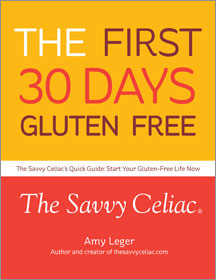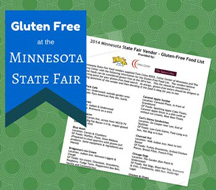Should Gluten-Free Folks be Worried about Arsenic Found in Rice?
September 20, 2012 by Amy Leger | G+ Amy Leger
Specialty GF items that have rice in them in our pantry. “X”s show items that probably would contain wheat and not rice if we weren’t GF. Note: Most of these products are not listed in the arsenic study.
(In September 2013 the FDA published its own investigation. Click here to see the follow-up story)
If you’re gluten free, there is a very good chance you are eating rice once a week, several times a week or in my daughter’s case at least once a day with breakfast. When you’re told to go gluten-free with celiac disease or a gluten intolerance, wheat, barley and rye are taken from your diet. Those are primary grains that we must now live without.
So what’s the substitution? Rice– is the most obvious– but quinoa is another, a lot of people do potatoes as a side dish as well.
Not only is rice something we might eat on the side with a steak, but it’s also used for any baked or grain-related foods that we want to replace our gluteny staples with: pasta, cereal and crackers to name a few!
Bottom Line: folks with celiac and gluten intolerance generally eat more rice and rice based products than people who eat the normal US diet (See photo upper right– RED X marks the products that I found in my pantry today that if we weren’t on a gluten free diet, likely would be purchased without rice in them)! So when the announcement came out that Consumer Reports was calling for Americans to limit our intake of rice because of potentially high arsenic levels….the response from the US in general might be shock, but from Gluten Free America– many might say– impossible.
What’s the Problem?
The Consumer Reports article calls the arsenic levels in some rice products “worrisome”. Arsenic in general terms is a known human carincogen. The article references the International Agency for Research on Cancer which has arsenic listed in its list of 100 Group 1 carcinogens. “It is known to cause bladder, lung and skin cancer in humans, with the liver, kidney, and prostate now considered potential targets of arsenic-induced cancers,” the article says.
Both the Food and Drug Administration and Consumer Reports admit that arsenic can also be found in some fruits, vegetabls and even water. According to an article by Reuters, inorganic arsenic, specifically, can be deadly in high doses and is linked to the aforementioned cancers. Organic aresenic is less concerning.
I am writing this article knowing that even my own daughter, on occasion, may have 3+ servings of rice a day, between cereal (2 bowls at breakfast), possibly rice served at school lunch and maybe a rice pasta at dinner. No we’re not an all-carb family, and that’s not a daily example of our diet — but let’s face it, in the US–we eat a lot of carbs. And many of us gluten free folks are more apt to turn to rice.
Common Gluten Free Products Tested
The brand names tested by Consumer Reports are VERY familiar to us: Arrowhead Mills, Tinkyada, Bob’s Red Mill, Trader Joe’s, Rice Dream, DeBoles, Rice Chex, Kellogg’s Gluten Free Rice Krispies and more. The list includes both regular rice and organic rice products. It seems no one who uses rice is immune. Consumer Reports says while they did test and list out certain brands, “it can’t be used for overall conclusions about specific brands”.
Consumer Reports says since there is no federal limit on arsenic in food, but a 10 ppb (parts per billion) limit on drinking water and a 5 ppb limit is the most protective standard in New Jersey. So using that as a yardstick, you can check on the products you buy by simply clicking here to see the products tested and their inorganic arsenic levels. One interesting note is that brown rice had higher levels of inorganic arsenic than white rice because the arsenic sits on the more nutritious outer layer of the rice.
In particular, Consumer Reports points out the concern about infant rice cereal. They say babies shouldn’t be exposed to this much arsenic and have asked that parents move their children to another infant cereal that is wheat, oat or corn based. And limit the rice cereal to 1/4 cup a day.
Consumer Reports also calls for the FDA to limit arsenic in rice as well as asking the Environmental Protection Agency to phase out the use of pesticides that contain arsenic.
What do we do?
At first glance, if we really were diligent, we wouldn’t purchase any premade items for us. By making everything from scratch we have control of what is in our food– including the rice content. Or we can explore different grains for our pastas, crackers and more.
But is this realistic? Rice is a staple in American food. Even more so in a gluten free diet.
For now, the FDA is not prepared to set recommendations on rice intake yet. FDA Commissioner Margaret Hamburg, MD said in a news release, “Our advice right now is that consumers should continue to eat a balanced diet that includes a wide variety of grains- not only for good nutrition but also to minimize any potential consequences from consuming any one particular food.” The FDA says it is in the process of testing 1200 samples from rice products and drinks (FDA’s list of products tested so far and their results click here). They says full data collection will be complete by the end of this year. Click here for FDA answers to common questions on this topic.
The end of the Consumer Reports article also offers suggestions on how to cut your arsenic risk– even for folks on the gluten-free diet. One easy change would be to rinse your rice before cooking it.
I am not recommending people change their intake of rice, you can make that decision on your own. This article was purely to bring out the information and highlight it in a gluten free way for people with celiac disease and gluten intolerance. There are several links inside this article and I encourage you to read them all and make your own decisions as we await further investigation from the US government.
Tags: arsenic, celiac, Consumer Reports, FDA, gluten-free, rice



September 20th, 2012 at 1:17 pm
I was only recently diagnosed with Celiac but have had severe food allergies (which can immediately kill me) to multiple foods since I was very young. It’s getting harder and harder to trust our food supply and it ends up that I’m choosing between the lesser of two (or three) evils: Do I want something that will kill me immediately? Slowly? Or just make me in unbearable stomach pain and ultimately damage my intestines? The lack of safety of our food supply makes me not want to eat at all!
September 21st, 2012 at 10:37 am
Thanks for the information, Amy. I’m in the exact same boat: my daughters and I eat a lot of rice, especially in the past 5 years. This is very disturbing to me, but as you say: what is realistic? We are not “only eat whole foods” or “paleo” kind of people for many reasons. Sure, it would be nice to be able to make everything from scratch, but that’s just not reality. I just emailed Chipotle to find out more about their rice as we eat there once every week or two, ordering a few of their rice bowls. I’m definitely going to try and cut down on rice but “eating a wide variety of grains” isn’t that easy for Celiacs. It’s disgraceful how unregulated this stuff is in our country, which is supposed to be so advanced….
September 21st, 2012 at 10:54 am
If you really try & put forth the effort, you CAN eliminate rice. Not are my girls GF but they also are allergic to rice. So yup, they eat GF & RF.
September 23rd, 2012 at 5:47 pm
I was surprised to see this article and I’d be lying if I said I wasn’t concerned. But, knowing how these scare tactics go and we hear about them regularly I almost want to take this with a grain of…rice? (Sorry, couldn’t help myself)
It is ridiculous how our food is regulated for sure, but moving to a cleaner way of eating and beginning baby steps toward planning our own kind of convenience with from scratch foods (bars, breakfast cookies, etc.) and even growing some of our own foods we will be less reliant on the gmo ‘food’ produced for the masses that got us here in the first place. And I’m definitely not there yet either, but an article like that does strengthen my resolve to try to keep plugging away trying to get there.
September 24th, 2012 at 6:51 am
I have a huge problem . My son is 6 and is allergic to wheat,corn and oats and many other things . He is also a high carb kid , making rice a huge part of his daily intake ( cereals,pancakes,waffles, bread, crackers,pasta,cookies etc) we are trying to replace some of those foods with potato and tapioca flour but are having a hard time finding recipes . I am so upset !! Any advice ?
September 24th, 2012 at 12:19 pm
Lisa, could you share what you use for baking flour, crackers, pasta, etc? Would love some tips to going rice-free. Thanks!
September 25th, 2012 at 8:33 am
Folks, if you think the FDA is there to protect us think again. Same can be said of the USDA and other so-called government bodies in place to protect the consumer. They’ve allowed our water and food supplies to become overwrought with chemicals and poisons. Today, 90% of our crops are genetically altered and recently GE corn is said to be linked to cancers, particularly breast cancers. If the FDA was in place to protect us . . . the consumer, they’d have stopped a great deal of the food production “methods” used. They won’t because their bottom line is money. I’m a free market capitalist by the way. But this is just the bottom line truth of the matter. I know more people today in their 40s and 50s fighting cancers of some type than I’ve ever known in my lifetime.
September 27th, 2012 at 10:32 pm
Lori, Have you tried Bob’s Red Mill gluten free All Purpose Flour? It has garbonzo, potato, tapioca, sorghum and fave bean flours. A friend of mine bakes with almond meal. Her cookies are delicious and egg free. I also read that gluten free flour needs to mimic wheat by mixing high protein and high starch flours. There are some good recipes on the internet. Good luck finding foods to feed your son.
September 28th, 2012 at 1:53 pm
Gluten Free Life bakery has always been a rice free, dedicated gluten free bakery.
Check out the products!
http://www.gflife.com/index.htm
October 1st, 2012 at 10:37 pm
Are folks reading the labels to see where their food is being grown and processed? Many labels are showing China. We all know about the apple juice fiasco from China. Wegman’s corn pasta is made in Romania Substitute potatoes? They are one of the most sprayed crops. And then they are part of foods in the nightshade family along with tomatoes, peppers and eggplant which give older people problems wth arthritis-like pains in the joints. Coconut? Are you reading the labels are the cartons of coconut milk, almond milk, rice milk with all the additives.
There companies who guarantee there rice is organic and arsenic free and they make gluten-free mixes.
October 19th, 2012 at 9:51 am
I agree with you about the benefit of eating rice in replace for wheat and barley foods. It does not only helps you on your diet, it also gives you the right nutrients in your daily life. rice is carbohydrates and is very good for the body, it’s a very healthy option.
November 21st, 2012 at 3:46 am
I would definitely cut back on rice, however arsenic is very hard to purge from your body – as well as the other junk like heavy metals that are prevalent in pretty much everyone these days. It all builds up until you reach toxic overload which causes fatigue, memory loss, depression and irritability. Sound familiar?
There is hope though…
Of all the ways to detox – the easiest and safest is very simple, heat and sweat. Sweating is the bodies way of cleansing itself. The best way to do this is with an infrared sauna, I got a portable one online for under $200 and it has done wonders for me healthwise in just a few weeks! The heat from infrared (harmless unlike the other end of the spectrum UV) penetrates deeper into the skin and produces greater results then exercise alone.
Good luck guys, we may not get it out of our food but we CAN get it out of our bodies.
January 5th, 2013 at 1:46 pm
I live in England and have been on a gluten-free diet since July 2010. This was my own decision through research, having suffered with I.B.S. symptoms for most of my adult life.
What stunned myself and the checkout operators at my local supermarket the most was the fact that there was such a wide variety of this produce now on sale and some lines such as the gluten-free bread and cakes were among their most popular sales.
That suggests to me a huge increase in peoples with intestinal diseases over the last decade or so.
Whats happening????
March 19th, 2013 at 4:34 am
Hi
It makes me sick to the stomach to see what they are doing to our food. We are at the mercy of big greedy companys, who for the allmighty dollar , poison our food supply. I own a food additive book, which I take shopping with me. Its sick to see that there are literaly thousands of poisons put into the foods we consume. They have just added flouride into our cities water supply, and the council would not allow the rate paying people to vote for it. Flouride is a poison which is a by product of alluminum. The Government said the it would erradicate tooth decay. One can choose to buy the flouride tablets. b It causes the elderly peoples bones go to chalk.
Does the gov. really care about our teeth, when there are big bucks to be made. What about the people who cannot afford to go to the dentist. And the homeless,who live in sheer poverty, where is the Gov.to help these people. Or do they really know how to cull the population. Think about it. They know what these poisons do, but they do nothing. $$$$$$$$$$$$$$$$$$$$$$$$$$$$$$$$$$$$$$$$$$ comes first.
November 7th, 2013 at 5:34 pm
A year later and I understand that Consumer Reports has an update article. The study showed the levels of arsenic in rice is worse than the government thought. It will be interesting to see how the gluten free food industry deals with this.
November 7th, 2013 at 6:34 pm
Yes Maureen. I wrote about it on September 6th of this year. You can see the follow up: http://www.thesavvyceliac.com/2013/09/06/new-developments-on-arsenic-in-rice-fdas-investigation/
Thanks!
June 2nd, 2014 at 4:30 am
Without wanting to sound like a sales pitch, we grow rice on a small farm on the island of Mauritius which we had tested for organic and inorganic arsenic at Brooks Rand Lab in Seattle. The results were 5 ppb and <8ppb (below detectable limit) for organic and inorganic arsenic.
We never sought out to grow 'low arsenic rice' but we think this characteristic of our rice came together fortuitously. We are the first and only rice growers in the country and the land we farm has never been intensively farmed in the past. Additionally, due to the slope of the farm, we are unable to flood irrigate our rice – instead we depend solely on rain water for irrigation with the crop growing on dry land. The use of flood irrigation has been theorised as a possible cause of the high arsenic uptake.
November 1st, 2015 at 10:09 am
To Lori C. and others on a gluten free lifestyle, be wary of gluten free breads, crackers, and other products as most replace gluteny wheat flour with tapioca and/or potato starch. Theses starches raise your blood sugar level rapidly. They are NOT healthy replacements. Research the problems that occur with rapidly elevated blood sugar.
I’m also gluten intolerant and looking for ways to replace gluten food with healthier and more convenient options. Unfortunately, I’m constantly led back to whole, organic food. But the good news is, if we ALL start avoiding the toxic food in the center isles of the grocery stores, and buy organic, the message will get out that we want healthier food. It will become more available
(many food companies are already joining the bandwagon), and eventually, cheaper and more convenient….LETS START VOTING WITH OUR DOLLARS!!!